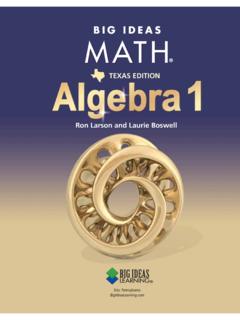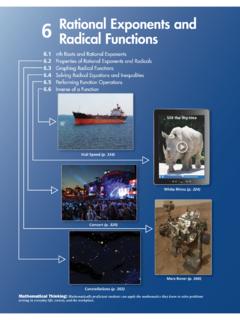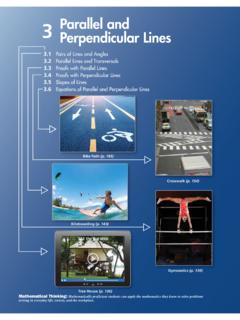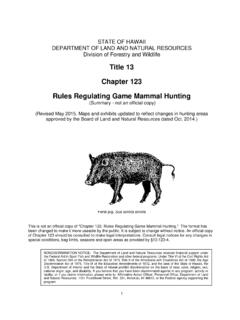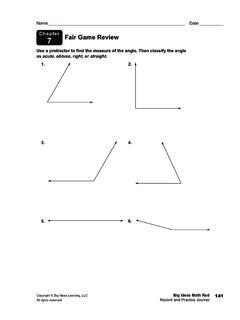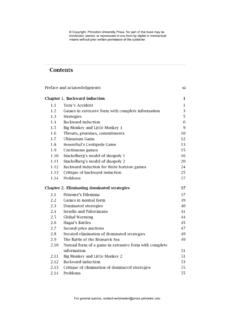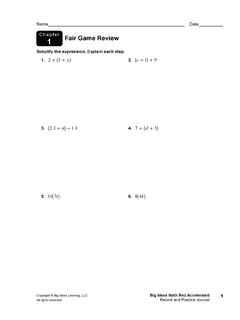Transcription of Big Ideas Math Grades 6 Math Curriculum Evaluation Toolkit
1 Big Ideas math Grades 6 8 math Curriculum Evaluation Toolkit Prepared for the State of California February 2014 Big Ideas math 6-8 Curriculum Evaluation Toolkit Page | 1/79 SECTION ONE | TOPIC ONE Page 14 of Toolkit Look for the Following in grade 6: a) The Big Ideas Textbook uses visual fraction models and story contexts as well as equations to represent fraction and division problems. (Page 5 of NS Progression and ) Models, pages 54-57; 62-65 Stories, pages 50-71 Expressions/Equations, pages 111-142; 310-312 b) The Big Ideas Textbook introduces the entire system of rational numbers, beginning in sixth grade , (page 7 of progressions) Page 248 with the Essential Question of How can you represent numbers that are less than 0? Pages 260-265. c) The grade 6 textbook DOES NOT add, subtract, multiply or divide negative rational numbers. ( ) See chapter 6. Look for the following in grade 7: a) The Big Ideas textbook represents addition and subtraction of rational numbers on horizontal and/or vertical number line diagrams.
2 ( ) Pages 50-51, 58-61 b) The Big Ideas textbook justifies that a negative times a negative is positive. (NS Progression and ). Pages 64-67 Look for the following in grade 8: a) The Big Ideas textbook introduces irrational numbers and uses rational approximations to locate them approximately on the number line ( ). Pages 310-313 Big Ideas math 6-8 Curriculum Evaluation Toolkit Page | 2/79 SECTION ONE | TOPIC TWO Page 16 of Toolkit Look for the following in grade 6: a) The Big Ideas textbook supports students using strategies for solving proportion problems, rather than setting up equations (progressions). b) Ratio s using Tape Diagrams, page 193 Ratio Tables 196-197 Using Double Number Lines page 205, Percent models page 218-219; 224-225 Look for the following in grade 7: a) In the Big Ideas text, Students engage with tables, graphs, equations, diagrams, and verbal descriptions of proportional relationships.
3 ( ) Tables, pages 163-165 Graphs, pages 165-166; 176-177 Verbal Descriptions, pages 170-171 Diagrams, pages 175, 178 b) Students graph proportional relationships and interpret points (x, y) on the graph in terms of the situation, with special attention to the points, (0,0), and (1,r), where r is the unit rate. (7. RP. 2d) . Pages 176-177 Look for the following in grade 8: a) The Big Ideas text s treatment of functions routinely engages students with four representations: algebraic, graphical, numerical in tables, and verbal descriptions. ( ) Algebraic: 250-252; 301 Graphical: 250-252;257; 260; 266-269 Numerical Tables: 243-245; 251-252; 257; 259-260; 266-269; 289 Verbal Descriptions : 250-252; 259-260; 301 Big Ideas math 6-8 Curriculum Evaluation Toolkit Page | 3/79 SECTION TWO | CATEGORY ONE | PART ONE Page 19 of Toolkit Category 1: Mathematics Content/Alignment with the Standards.
4 Lesson A 6th grade (Green): Dividing Fractions (pages 62-69) NO YES 1 2 3 4 5 Lesson A a. 5 no mistakes b. 5 all facts information is accurate c. 5 written with precision *see color coding for vocabulary; The Meaning of the Word, and Key Ideas d. 5 math terms are defined/appropriate e. 5 The Big Ideas textbook uses the given definitions to develop student understanding *see The Meaning of the Word f. 5 There is no material in this lesson outside of CCSS. g. 5 Materials amply feature high-quality conceptual problems and questions *see page 62 and 63 h. 5 Manipulatives and concrete representations such as diagrams *see pages 62-63, 6568-69 i. 5 Methods and algorithms are general and based on principles of mathematics, not mnemonics or tricks. Big Ideas math 6-8 Curriculum Evaluation Toolkit Page | 4/79 Lesson B 6th grade (Green): Solving Percent Problems (pages 224-231) NO YES 1 2 3 4 5 Lesson B a.
5 5 no mistakes b. 5 all facts information is accurate c. 5 written with precision *see color coding for vocabulary; The Meaning of the Word, and Key Ideas d. 5 math terms are defined/appropriate e. 5 The Big Ideas textbook uses the given definitions to develop student understanding *see part and whole f. 5 There is no material in this lesson outside of CCSS. g. 5 Materials amply feature high-quality conceptual problems and questions *see page 224-228 h. 5 Manipulatives and concrete representations such as diagrams *see bar models and tables i. 5 Methods and algorithms are general and based on principles of mathematics, not mnemonics or tricks. Lesson C 7th grade (Red): Solving Equations Using Addition or Subtraction (pages 96-101) NO YES 1 2 3 4 5 Lesson C a. 5 no mistakes b. 5 all facts information is accurate c. 5 written with precision *see color coding for vocabulary; Key Ideas , language d.
6 5 math terms are defined/appropriate e. 5 The Big Ideas textbook uses the given definitions to develop student understanding *see stepped-out examples f. 5 There is no material in this lesson outside of CCSS. g. 5 Materials amply feature high-quality conceptual problems and questions *see pages 96-97 h. 5 Manipulatives and concrete representations such as diagrams *see bar models and tables ; see pages 96-97 i. 5 Methods and algorithms are general and based on principles of mathematics, not mnemonics or tricks. Big Ideas math 6-8 Curriculum Evaluation Toolkit Page | 5/79 Lesson D 7th grade (Red): The Percent Proportion (pages 226-231) NO YES 1 2 3 4 5 Lesson D a. 5 no mistakes b. 5 all facts information is accurate c. 5 written with precision *see color coding for vocabulary and Key Ideas d. 5 math terms are defined/appropriate e. 5 The Big Ideas textbook uses the given definitions to develop student understanding *see The Meaning of the Word f.
7 5 There is no material in this lesson outside of CCSS. g. 5 Materials amply feature high-quality conceptual problems and questions *see page 226-227 h. 5 Manipulatives and concrete representations such as diagrams *see pages 226-227, bar models and tables i. 5 Methods and algorithms are general and based on principles of mathematics, not mnemonics or tricks. Lesson E 8th grade (Blue): Congruent Figures (pages 42-47) NO YES 1 2 3 4 5 Lesson E a. 5 no mistakes b. 5 all facts information is accurate c. 5 written with precision *see color coding for vocabulary and Key Ideas d. 5 math terms are defined/appropriate e. 5 The Big Ideas textbook uses the given definitions to develop student understanding *see The Meaning of the Word f. 5 There is no material in this lesson outside of CCSS. g. 5 Materials amply feature high-quality conceptual problems and questions *see pages 42-43 h.
8 5 Manipulatives and concrete representations such as diagrams *see pages 42-43 i. 5 Methods and algorithms are general and based on principles of mathematics, not mnemonics or tricks. Big Ideas math 6-8 Curriculum Evaluation Toolkit Page | 6/79 SECTION TWO | CATEGORY ONE | PART TWO Page 24 of Toolkit Lesson A 6th grade (Green): Ratios (pages 190-195 and TE T-190-T-195) YES / NO Where are the SMP s located? In the Big Ideas text, the SMP s are embedded throughout the lesson. The program highlights at least two in each lesson. The SMP s are highlighted in the side column of the student text (page page 191) and in Laurie s Notes in the TE (T-190). They are also embedded in multiple applications used throughout the lesson. YES Are there one or two SMP s at the forefront of the lesson? math Practice 4, Using a Table or Diagram and Construct Viable Arguments are two that are very visible.
9 See Activities 2 and 3. YES Are they explicitly applied in the lesson outline? On the website, teachers are provided lesson plans for the SMP, and a call out note to students in the margin. The Call Out note includes a think about it question to help establish the habit. Laurie s Notes provide suggestions and help for teachers to guide students in their development of these habits. (see T-191) YES Is the lesson true to the SMP s listed? Students are asked to write statements and describe relationships (Activity 2), use diagrams (Activity 3) and explain their answer to the Essential Question and support that explanation (What is Your Answer 5 and 6). Lesson B 6th grade (Green): Adding and Subtracting Decimals (pages 78-83 and TE T-78-T-83) YES / NO Where are the SMP s located? In the Big Ideas text, the SMP s are embedded throughout the lesson. The program highlights at least two in each lesson.
10 The SMP s are highlighted in the side column of the student text page 79) and in Laurie s Notes in the TE (T-78). They are also embedded in multiple applications throughout the lesson. YES Are there one or two SMP s at the forefront of the lesson? math Practice 3, Analyze Conjectures and Look for and Make Use of Structure are very visible in the lesson. See Activities 1-3. YES Are they explicitly applied in the lesson outline? On the website, teachers are provided lesson plans for the SMP, and a call out note to students in the margin. The Call Out note includes a think about it question to help establish the habit. Laurie s Notes provide suggestions and help for teachers to guide students in their development of these habits. (see T-79) YES Is the lesson true to the SMP s listed? Students are asked to make and use conjectures (page 79) as well as using models to look for and make use of structure (page 78).
